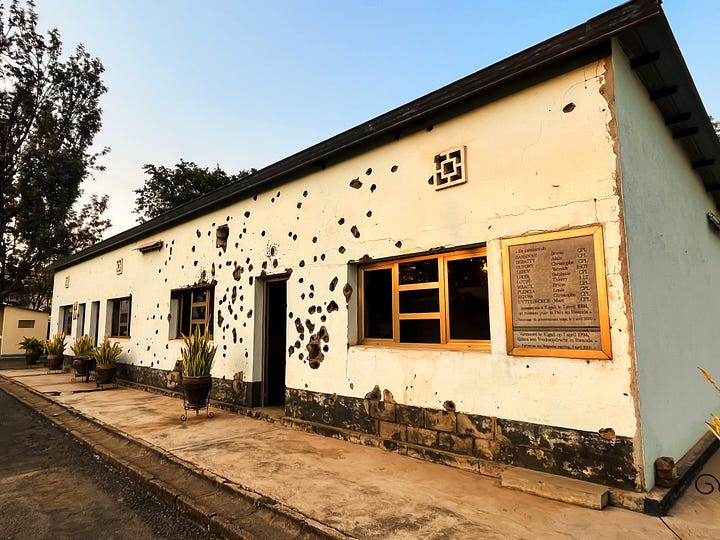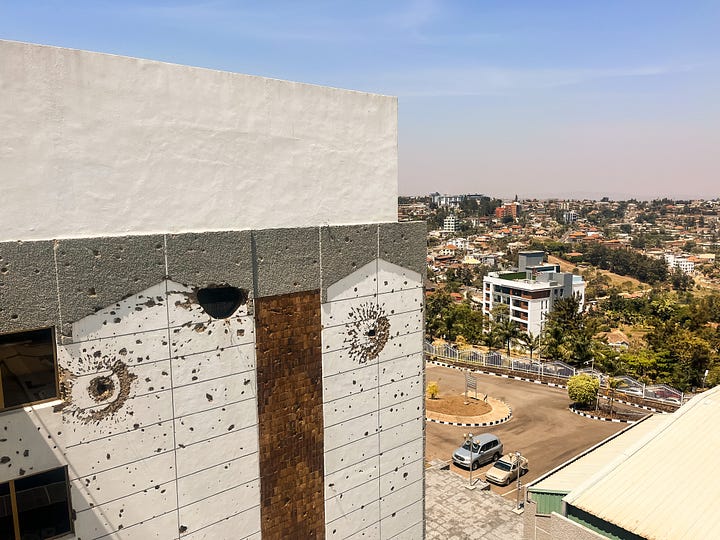Initially we didn’t know a lot about Rwanda, except - of course - about the Genocide in 1994, and the fact that Rwanda, as the progressive model state in Africa, recently made headlines when it banned single-use plastic. As we were anyway close to the border, we decided to spend some time with our neighbours. We have had interesting border crossing experiences in Asia in the past, but it being the first in Africa, and considering that we had to “import” a Ugandan car, we were unsure of what challenges were ahead of us. As is common at land borders in developing countries, you find all sorts of so-called “helpers” (scammers) hanging around, and sometimes you need to avail of these so-called helpers to make things more tolerable. However, the border to Rwanda was relatively quiet and the processes were clear and straightforward. The immigration officer was slightly suspicious of us, and conducted a ten minute interview. He was wondering what the hell this Swiss-Irish Muzungu couple with an Ugandan registered car and no detailed itinerary whatsoever (our speciality) wanted to do in Rwanda - usually tourists arrive here with meticulously planned tours and 99% of the time will mention the word “gorillas”. Nonetheless, we were able to avoid all scammers, convinced the immigration officer, got our visas validated, and managed to import the car at no additional hassle or costs. Rwanda is known as being very transparent and a relatively corruption-free country (fourth least corrupt country in Africa), which was also confirmed by our first impressions.
Perfect roads, rolling hills, orderly and clean, lots of people on bicycles… When we drove across the Ugandan border at Gatuna and into Rwanda, it was clear to us why Rwanda is often referred to as „The Switzerland of Africa.“ Riding through the tea plantations and lush green countryside is a treat for the senses. Every single inch of land is meticulously cultivated and with the car windows open, the air carries in a strong aroma of eucalyptus. The route to Kigali takes you through little towns and bustling villages where the spirit of community is strong. It appears that bicycles transporting literally EVERYTHING. Suddenly we were woken up out of our dreamy drive by a police woman who waved us down on the road. Of course we stopped, and it turned out that she was hitching a ride to work. She hopped into the back seat of our car and sat there in her full uniform as quiet as a mouse. We were still feeling a bit awkward after the questioning at immigration, and knowing that despite the economical openness you must watch what you say in this country (especially anything critical about the president and his government), we kept our conversation as casual as possible. We couldn’t help wondering if she was planted there by the border police… Was her task of the day to hitchhike with the two Muzungus and find out what we were up to? Who knows… All we know is she got a free ride to work to the police station that day, and she even got offered some biscuits.
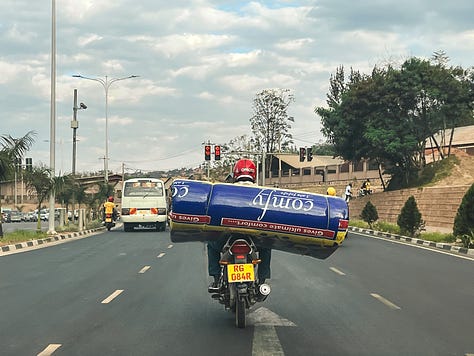
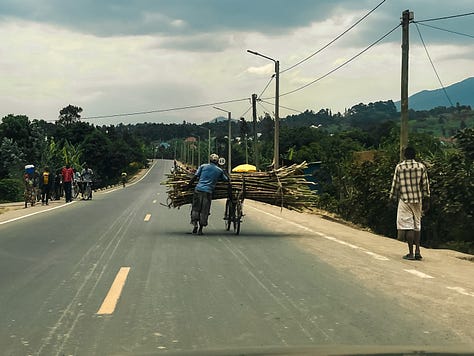
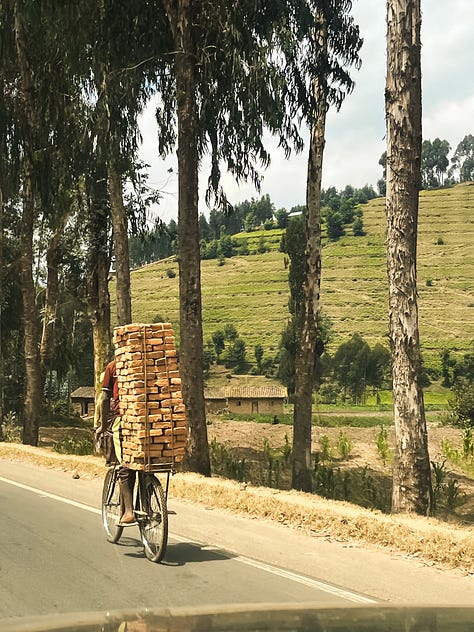
As you drive into Kigali the huge city emerges from the hills. The streets are packed with boda bodas, but the one striking difference to Uganda is that all streets have side-walks and every single person on a motorbike is wearing a helmet. The city feels progressive, yet charming at the same time. The boulevards are extremely well maintained and the buildings are a contemporary and traditional fusion, which creates a really inviting urban landscape. The culinary scene caters to every palate with its many restaurants, and there are cafes and bars on every corner. Although waiting until you’re verging on hangry to go eat at a restaurant here is not ideal, given that you can sometimes wait 1 - 1.5h for your food to arrive at your table. African time is in full swing here, and the Swiss punctuality definitely hasn’t caught on. But we won’t complain when the beers are 80 cents…
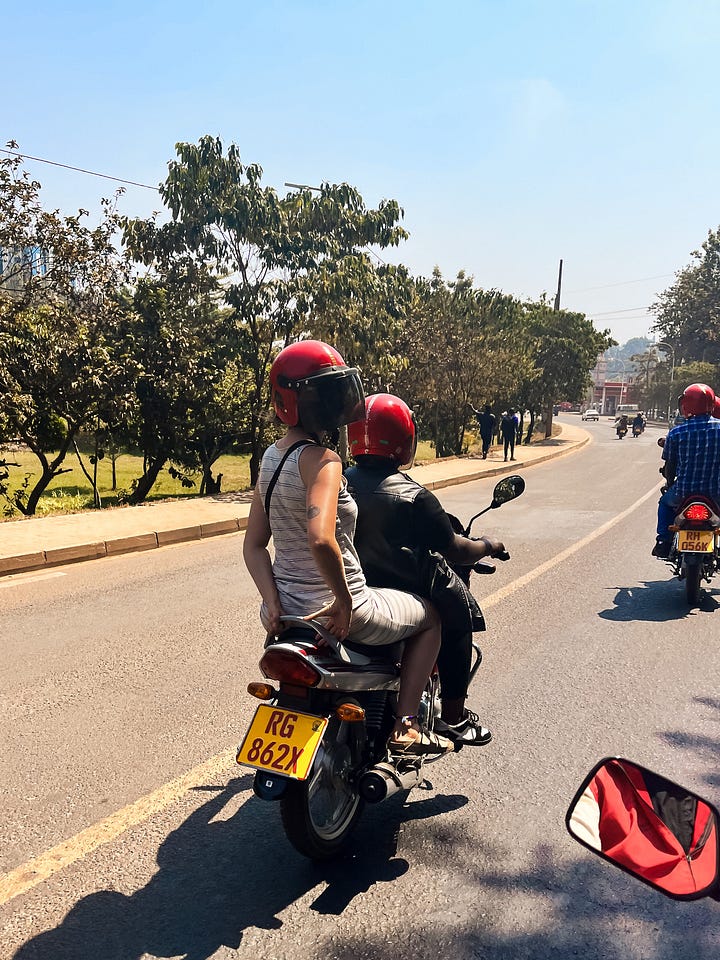
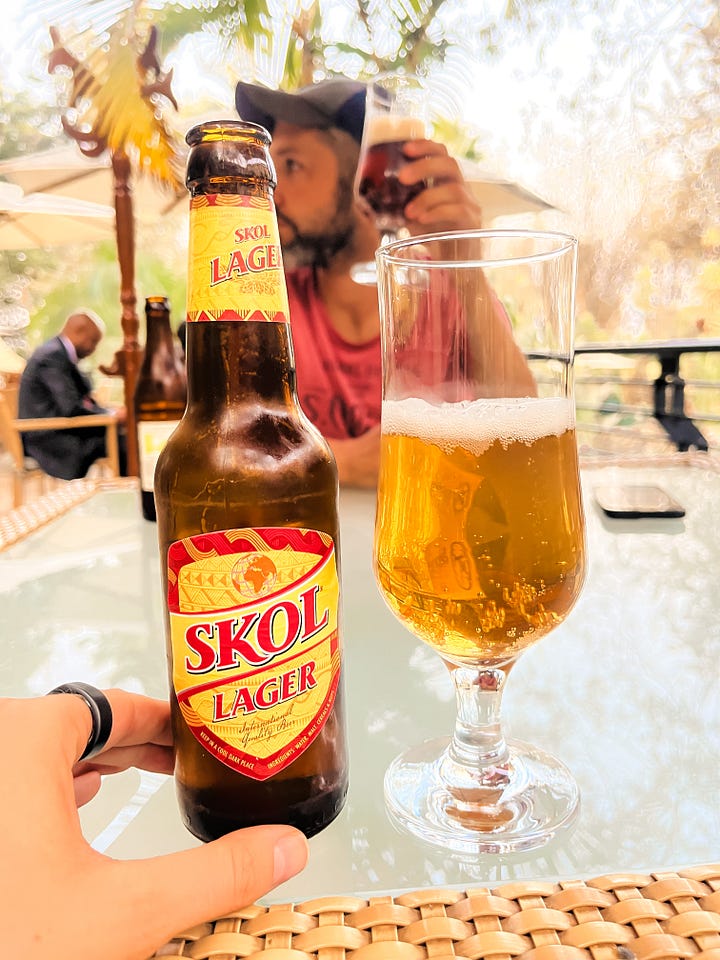
One undeniable similarity between Switzerland and Rwanda is their obsession with dairy. We’re all familiar with Swiss cheese and Alpine butter and milk, but were you aware that in Rwanda there are milk BARS?! Forget beer, it’s MILK that’s on tap. Fresh or fermented, hot or cold. Men and women, young and old, sit on benches and plastic chairs throughout the day, glass mugs in hand, gulping liters upon liters of fresh milk. But there is also an interesting reason for this… Over the centuries cows were a source of wealth and status in Rwanda. Historically the Tutsis were herdsmen, considered very rich in cattle, and were targeted by the Hutu ethnic group during the genocide in 1994. Almost 1 million people were slaughtered within 100 days, the majority being the Tutsis. As Rwanda recovered from the genocide, the government looked to cows again as a way to grow the economy and fight malnutrition. They introduced a program that aimed to give every poor family a cow, which resulted in hundreds of thousands of cows nationwide, and a huge increase in milk production. As the milk production increased, so did the number of people who moved from rural areas to urban areas for education and employment. And so the milk bars were born. In fact, most milk bars are in the capital city - perhaps a reminder of home to the customers who left their rural villages to pursue their dreams? Like us?
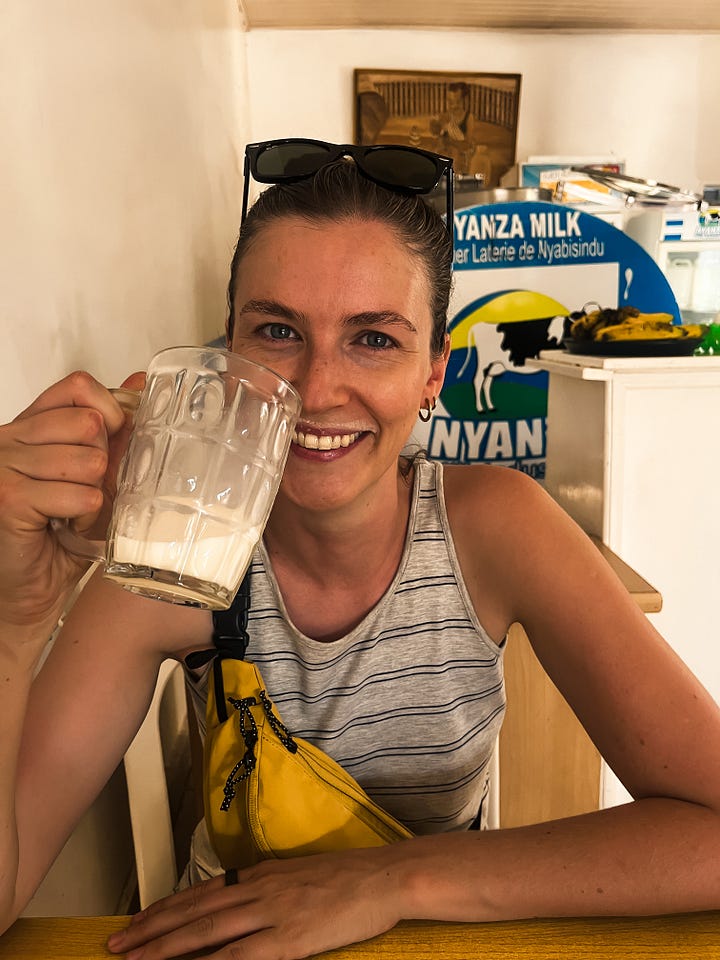
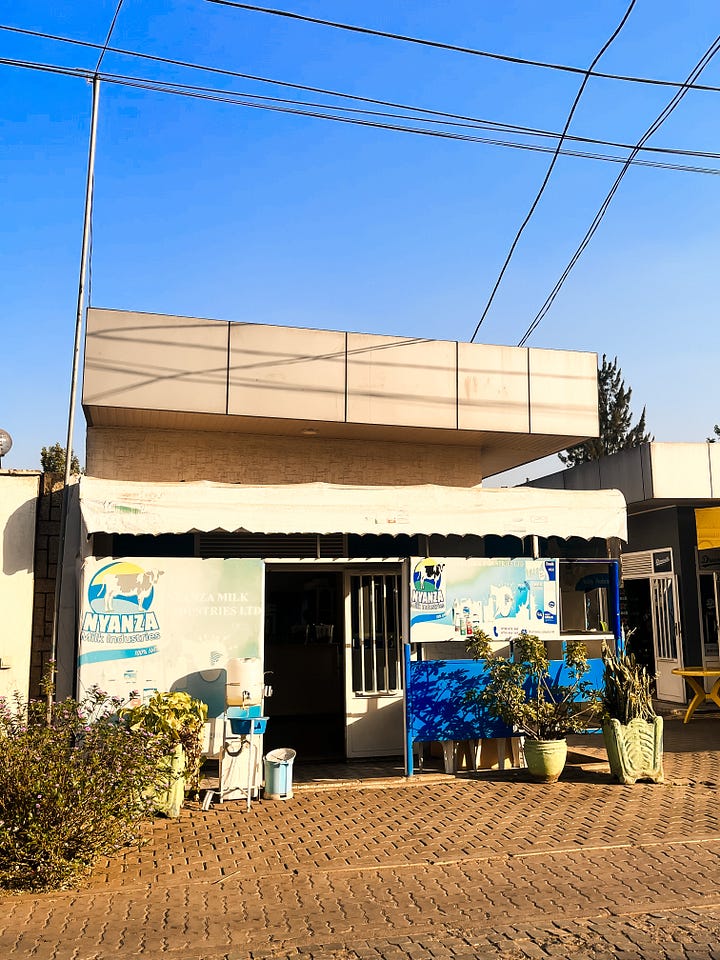
Another thing that Switzerland and Rwanda have in common is the fact that neither of them is a destination for a budget traveler. While Rwanda’s nature and wildlife are undoubtedly captivating, a visit to your gorilla cousins in the famous Virunga National Park will set you back a hefty 1,500$. That price only covers the park permit with guides, without any accommodation or additional conveniences. Rwanda is strongly committed to sustainable tourism, well-preserved attractions, and conservation, which understandably comes at a cost. Accommodation options often lean towards upscale lodges and expensive boutique hotels, which is why we opted for mix of camping, staying at a Benedictine Nunnery, sleeping in an art gallery, and staying with (new) friends - all of which were really special experiences. We camped at two beautiful camp sites, one at Lake Kivu, and one at Lake Ruhondo. Both are exceptionally beautiful lakes, free from pollution and nestled in the lush landscapes of the Great Rift Valley. Our campsite on Lake Ruhondo was surrounded by water on three sides, and had a view of the volcanoes in Virunga National Park - we doubt that we will find a camping spot again that would beat that.
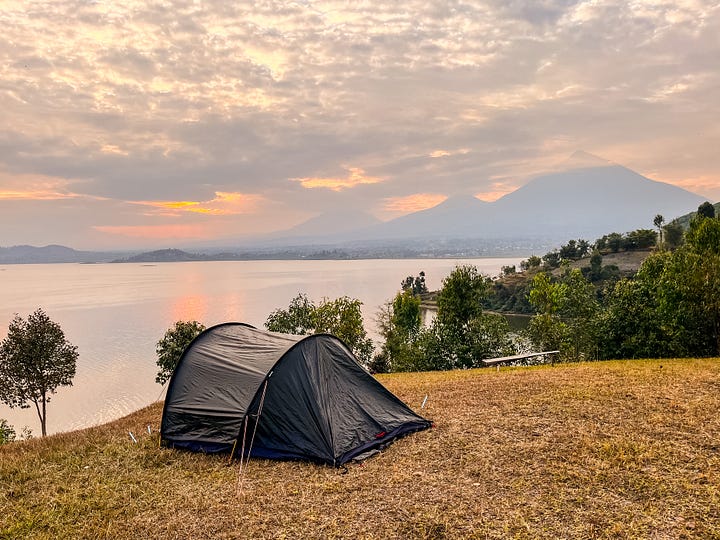

While Switzerland’s reputation for clean streets and eco-vibes is well-deserved, Rwanda has taken the green initiative to a whole new level. One of the most notable policies is Rwanda’s ban on single-use plastic bags, which came into force already in 2008. In addition to this bold move, Rwanda has invested in reforestation programs, renewable energy sources, and sustainable agriculture practices to reduce carbon emissions and enhance ecosystem health. A 2021 report by the Rwanda Ministry of Infrastructure reported that 62.3% of total power generated was delivered from a renewable energy source. Central to Rwanda’s green revolution is its emphasis on community participation and environmental education. To encourage active engagement at the grassroots level, a program called “Umuganda” was (re-)introduced in 1998. Umuganda brings citizens together on the last Saturday of every month to participate in activities like waste collection, tree planting, and infrastructure improvement. This collective action program has fostered a sense of pride and ownership among the Rwandans, and they tend to take extremely good care of their environment as a result. While we were at Lake Kivu we visited the one and only Museum of the Environment in the whole of Africa. It’s an educational centre (a bit like the Umwelt Arena in Zürich) with the purpose of helping people to understand and safeguard their environment, and ensure integrated and durable development. Rwanda truly leads the way towards a greener future in Africa!
While the worlds of Switzerland and Rwanda may seem oceans apart, they share more similarities than meets the eye. However it’s important to remember that Rwanda rose out of the shadows of a genocide a mere 30 years ago. The 100 day genocide devastated the country and the scars of its past serve as a reminder of the immense challenges that were faced. The country’s remarkable journey of recovery and resilience stands as a testament to human’s capacity to overcome the darkest of horrors. Rwanda has defied all odds. If you are interested to learn more about the nation’s story, we strongly recommend the virtual tour of the genocide museum, which is an extremely high quality 3D experience and is available for free at the following link: https://kgm.rw/visit/virtual-tours/
